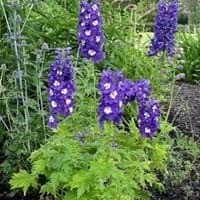Life Span
Perennial
Annual
Type
Flowering Plants, Ornamental Plants, Shrubs
Vegetable
Origin
Africa
Central America, South America
Types
Not Available
Willow Leaf, Sieva Lima, Dixie Speckled
Number of Varieties
Not Available
Habitat
gardens, meadows
Humid climates, Subtropical climates, Warmer regions
USDA Hardiness Zone
Not Available
6-11
AHS Heat Zone
12 - 6
Not Available
Sunset Zone
Not Available
Not Available
Habit
Upright/Erect
Vining/Climbing
Flower Color
Blue, Indigo, Lavender, Light Purple
White, Ivory
Flower Color Modifier
Bicolor
Bicolor
Fruit Color
Not Available
Green
Leaf Color in Spring
Green
Green
Leaf Color in Summer
Light Green
Green
Leaf Color in Fall
Green, Yellow green
Green
Leaf Color in Winter
Green, Light Yellow, Tan
Green
Leaf Shape
Palmate and toothed
Willow-shaped
Plant Season
Spring, Summer, Fall, Winter
Not Available
Sunlight
Full Sun, Partial Sun
Full Sun
Type of Soil
Clay, Loam, Sand
Loam, Sand
The pH of Soil
Acidic, Neutral, Alkaline
Acidic, Neutral, Alkaline
Soil Drainage
Well drained
Well drained
Bloom Time
Not Available
Indeterminate
Tolerances
Heat And Humidity
Drought
Where to Plant?
Ground, Pot
Container, Ground, Pot
How to Plant?
Seedlings, Stem Cutting
Seedlings
Plant Maintenance
Medium
High
Watering Requirements
It cannot sustain wet-feet, Keep ground moist, Requires regular watering, Water more in summer
Allow to dry out slightly between watering, Do Not over Water, Requires regular watering
In Summer
Lots of watering
Not so frequently
In Spring
Moderate
Alternate Days
In Winter
Average Water
Drought Tolerant
Soil pH
Acidic, Neutral, Alkaline
Acidic, Neutral, Alkaline
Soil Type
Clay, Loam, Sand
Loam, Sand
Soil Drainage Capacity
Well drained
Well drained
Sun Exposure
Full Sun, Partial Sun
Full Sun
Pruning
Cut away fading foliage, Do not prune during shooting season, Remove damaged leaves, Remove deadheads
Prune to control growth
Fertilizers
High-phosphorous fertilizers used, Organic Flower Fertilizer
organic fertlizers
Pests and Diseases
Bacterial leaf spot, fungus, Mealybugs
Aphids, Armyworm, Bean rust, Bean weevils, Corn earworm, Cucumber beetles, Curly top, Damping off, Darkling beetles, Earwigs, Fusarium root rot, Grasshoppers, Leafhoppers, Loopers, Lycaenid pod borers, Lygus bugs, Mosaic viruses, Nematodes, Powdery mildew, Saltmarsh caterpillar, Seedcorn maggot, Slugs, Snails, Spider mites, Stink bugs, Thripes, White mold, Whiteflies
Plant Tolerance
Heat And Humidity
Drought
Flowers
Yes
Insignificant
Flower Petal Number
Single
Single
Fragrant Flower
Yes
Not Available
Fragrant Fruit
No
Not Available
Fragrant Leaf
No
Not Available
Fragrant Bark/Stem
No
Not Available
Showy Bark
No
Not Available
Foliage Texture
Fine
Medium
Foliage Sheen
Matte
Matte
Self-Sowing
No
Not Available
Attracts
Butterflies
Not Available
Allergy
Severe allergen, Skin irritation, Skin rash, Throat itching, Vomiting
Not Available
Aesthetic Uses
Beautification, Borders, Showy Purposes, Used for decorating walls, fences, gates, hedges, etc.
Not Available
Beauty Benefits
Not Available
Not Available
Environmental Uses
Air purification
Not Available
Medicinal Uses
Not Available
cholesterol-lowering, constipation, Digestive disorders, Fiber, Heart problems
Part of Plant Used
Flowers
Seeds
Other Uses
Used in making blue ink
Used As Food
Used As Indoor Plant
No
No
Used As Outdoor Plant
Yes
Yes
Garden Design
Edging, Feature Plant
Edible, Herb, Vegetable
Botanical Name
Delphinium elatum
PHASEOLUS lunatus
Common Name
Alpine delphinium, Delphium, Candle larkspur, Siberian larkspur, Musk Larkspur,
Butter Bean, Lima Bean
In Hindi
अल्पाइन Delphinium
सेम फली
In German
Alpine Delphinium
Limabohne
In French
Alpine Delphinium
Haricot de Lima
In Spanish
Alpine Delphinium
Haba
In Greek
Alpine Δελφίνιο
Γίγαντας
In Portuguese
Alpine Delphinium
feijão-Lima
In Polish
Alpine Delphinium
Lima Bean
In Latin
Alpine Delphinium
Lima Bean
Phylum
Tracheophyta
Tracheophyta
Class
Magnoliopsida
Magnoliopsida
Order
Ranunculales
Fabales
Family
Ranunculaceae
Fabaceae
Genus
Delphinium
Phaseolus
Clade
Angiosperms, Eudicots
Angiosperms, Eudicots, Rosids
Tribe
Not Available
Phaseoleae
Subfamily
Not Available
Faboideae
Number of Species
Not Available
Importance of Alpine Delphinium and Lima Bean
Want to have the most appropriate plant for your garden? You might want to know the importance of Alpine Delphinium and Lima Bean. Basically, these two plants vary in many aspects. Compare Alpine Delphinium and Lima Bean as they differ in many characteristics such as their life, care, benefits, facts, etc. Every gardener must at least have the slightest clue about the plants he wants to plant in his garden. Compare their benefits, which differ in many ways like facts and uses. The medicinal use of Alpine Delphinium is Not Available whereas of Lima Bean is cholesterol-lowering, constipation, Digestive disorders, Fiber and Heart problems. Alpine Delphinium has beauty benefits as follows: Not Available while Lima Bean has beauty benefits as follows: Not Available.
Compare Facts of Alpine Delphinium vs Lima Bean
How to choose the best garden plant for your garden depending upon its facts? Here garden plant comparison will help you to solve this query. Compare the facts of Alpine Delphinium vs Lima Bean and know which one to choose. As garden plants have benefits and other uses, allergy is also a major drawback of plants for some people. Allergic reactions of Alpine Delphinium are Severe allergen, Skin irritation, Skin rash, Throat itching and Vomiting whereas of Lima Bean have Not Available respectively. Having a fruit bearing plant in your garden can be a plus point of your garden. Alpine Delphinium has no showy fruits and Lima Bean has no showy fruits. Also Alpine Delphinium is flowering and Lima Bean is not flowering . You can compare Alpine Delphinium and Lima Bean facts and facts of other plants too.





